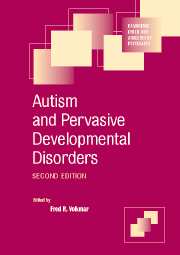Book contents
- Frontmatter
- Contents
- List of contributors
- Preface to the second edition
- 1 Diagnosis and definition of autism and other pervasive developmental disorders
- 2 Epidemiological surveys of pervasive developmental disorders
- 3 Psychological factors in autism
- 4 Communication and its development in autism spectrum disorders
- 5 Genetic epidemiology of autism spectrum disorders
- 6 The neurobiology of autism
- 7 Psychopharmacology
- 8 Behavioral and educational approaches to the pervasive developmental disorders
- 9 The outcome in adult life for people with ASD
- 10 Autism, social neuroscience, and endophenotypes
- Index
1 - Diagnosis and definition of autism and other pervasive developmental disorders
Published online by Cambridge University Press: 19 August 2009
- Frontmatter
- Contents
- List of contributors
- Preface to the second edition
- 1 Diagnosis and definition of autism and other pervasive developmental disorders
- 2 Epidemiological surveys of pervasive developmental disorders
- 3 Psychological factors in autism
- 4 Communication and its development in autism spectrum disorders
- 5 Genetic epidemiology of autism spectrum disorders
- 6 The neurobiology of autism
- 7 Psychopharmacology
- 8 Behavioral and educational approaches to the pervasive developmental disorders
- 9 The outcome in adult life for people with ASD
- 10 Autism, social neuroscience, and endophenotypes
- Index
Summary
Introduction
Autism and other pervasive developmental disorders (PDDs) are a phenomenologically related set of neuropsychiatric disorders. These conditions are characterized by patterns of both delay and deviance in multiple areas of development; typically their onset is in the first months of life (APA, 1994; Volkmar & Klin, 2005). Although often associated with some degree of mental retardation, the pattern of developmental and behavioral features differs from that seen in children with mental retardation not associated with PDD in that certain sectors of development, such as social interaction and communication, are most severely affected whereas other areas, such as nonverbal cognitive abilities, may be within normal limits. While the validity of autism has been relatively well established, issues of syndrome boundaries remain the topic of some debate (Bailey et al., 1996). In this chapter, the development of autism as a diagnostic concept, current definitions of the condition and of related diagnostic concepts, and their differentiation from other disorders will be reviewed.
Development of diagnostic concepts
Over the past 150 years, a major point of controversy has been the continuity, or discontinuity, of the severe psychiatric disorders of childhood with the adult psychoses. For example, the great British psychiatrist Maudsley suggested that children, like adults, could exhibit “insanity” (1867).
- Type
- Chapter
- Information
- Autism and Pervasive Developmental Disorders , pp. 1 - 32Publisher: Cambridge University PressPrint publication year: 2007
- 1
- Cited by

